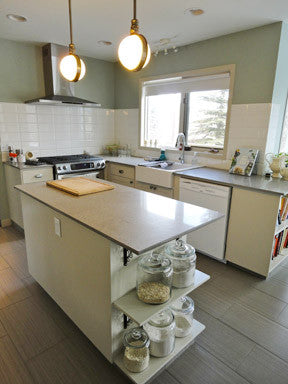The word "trend" is one of the words I have the most mixed feelings about as an interior designer.
 There's a part of me that almost feels yucky writing about them and yet they are important and clients often ask me how to keep their homes "on trend", while at the same time avoiding a "trendy" look. This seeming dichotomy has more to do with how the word is used in context and I'd like to try and demystify it. Over the next few weeks I will be talking about what you should and shouldn't pay attention to, how to keep your home from looking dated, giving it wide appeal and also keeping it personal. "Trends" will affect every aspect of those issues.
There's a part of me that almost feels yucky writing about them and yet they are important and clients often ask me how to keep their homes "on trend", while at the same time avoiding a "trendy" look. This seeming dichotomy has more to do with how the word is used in context and I'd like to try and demystify it. Over the next few weeks I will be talking about what you should and shouldn't pay attention to, how to keep your home from looking dated, giving it wide appeal and also keeping it personal. "Trends" will affect every aspect of those issues.
First, it's important to understand that there are long and short-term trends in home design.
Only long-term trends are worth paying really close attention to for the most part, and so I'd like to start by addressing those. Long-term trends are what keep a home from looking dated. I would define long-term trends as those that last between 10-15 years. They can be hard to spot at first and yet, it's very important to keep just ahead of the curve when designing a home. This is particularly true if you think it's possible you may want to sell within the next 10 years or so (and almost everyone can see that might be a possibility). It requires paying attention to what is up and coming and a bit of crystal ball gazing.
You can identify longer term trends that are coming to a close when the product or look has become ubiquitous.
It may still be popular and sometimes one has to buck that trend in order to be at the front of the next one. Just imagine how the very last guy who ever bought a leisure suit felt. He was probably waiting and waiting to see if leisure suits really were what everyone wanted and that it really was a "safe" choice. He finally buys one and bam, they're not popular anymore. We are seeing that now with espresso cabinetry that has been so popular for the last 10 years or so. Designers (and some clients) are starting to feel like it's time for a change. It will probably still be popular for quite some time and many people will still be asking for it. It still looks good, but it has really run it's course at this point and for long-term design planning and resale purposes, it may not be what I would suggest to a client coming to me for a kitchen renovation today.
Design magazines and blogs really are a fantastic resource for seeing what is up and coming.
Keep an eye out for what is unique in larger investment pieces (for the most part ignore that "tangerine" or "puce" is the colour of the season) and that will often help you to determine what is going to be next for larger overall renovation or building projects. For example, brown has had a long run as the popular neutral of choice, but you'll see now that more and more homes featured in design magazines showcase grey.
Of course, I am not advocating putting something into your home that you don't like and I don't ever suggest blindly following convention. That's how the whole leisure suit thing happened in the first place! Keep an eye out for what is unique, what may be starting to be something of a recurring theme and, of course, what appeals to you. Keeping an open mind is key here, because we have all become accustomed to certain looks and may automatically be drawn to what is most popular at the time. You need to discipline yourself to look beyond that.
I am very much in favour of highly personalized homes, but there are ways to have your cake and eat it too. That is, you can have a home that is yours in look and feel, but that could easily be tweaked into a space that most people could envision themselves living in (and that's what you need to sell your home). There's rarely only one look that is "in" so there are always options to chose from.
This is really a huge topic, so I am going to try and break it into bite size pieces over the next few weeks.
This topic is particularly important to me for one central reason: The longer people like something, the less likely it is to end up in the landfill after only a short run of use. Learning to effectively use long-term trends makes for more sustainable design and also is better for a client's pocketbook.

